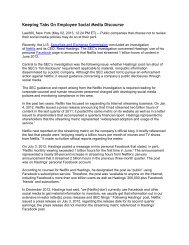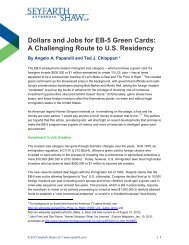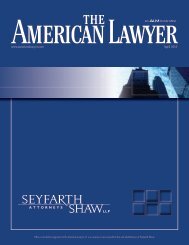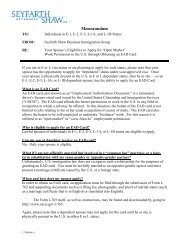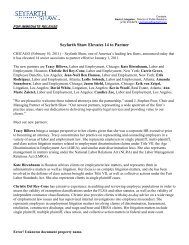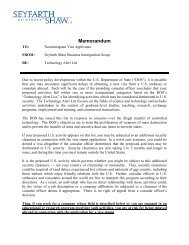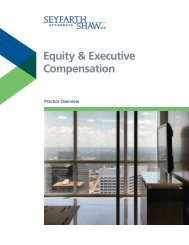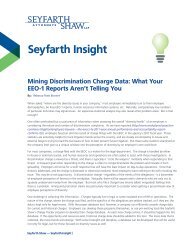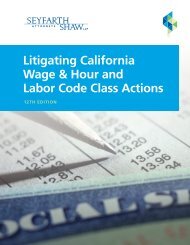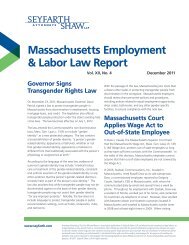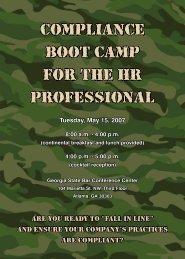ConstructionLawReport 7-06 v.2.qxp - Seyfarth Shaw LLP
ConstructionLawReport 7-06 v.2.qxp - Seyfarth Shaw LLP
ConstructionLawReport 7-06 v.2.qxp - Seyfarth Shaw LLP
You also want an ePaper? Increase the reach of your titles
YUMPU automatically turns print PDFs into web optimized ePapers that Google loves.
Construction Law Report<br />
Summer 20<strong>06</strong><br />
Sustainable Building: Managing the<br />
Environmental and Project Risks<br />
The design and construction of sustainable buildings<br />
that are environmentally responsible and healthy<br />
places in which to work, as well as profitable<br />
facilities, are matters of increased interest these<br />
days. The U.S. Green Building Council (USGBC) is<br />
a voluntary, national nonprofit organization that<br />
promotes “Green Design,” defined as design and<br />
construction practices that significantly reduce or<br />
eliminate the negative impact of buildings on the<br />
environment and occupants in five broad areas:<br />
• Sustainable site planning<br />
• Safeguarding water and water efficiency<br />
• Energy efficiency and renewable energy<br />
• Conservation of materials and resources<br />
• Indoor environmental quality<br />
To achieve their goal, the USGBC developed the<br />
LEED (Leadership in Energy and Environmental<br />
Design) Green Building Rating System®, which<br />
has gained significant popularity recently and is<br />
perhaps the most widely accepted method for<br />
measuring sustainability of building projects in the<br />
Unites States.<br />
The number of LEED registered projects for<br />
educational, commercial, multi-use and other types of<br />
facilities has increased exponentially over the past<br />
several years in both the public and private sectors.<br />
The core goals of the USGBC and its LEED rating<br />
system are well-defined and, despite its economic<br />
critics, there are ample statistics detailing substantial<br />
environmental, economic, health-safety and<br />
community benefits to building green.<br />
The potential pitfalls and risks associated with<br />
Green Building contracts are less clear. One<br />
(continued)<br />
Bob Rubin Honored as Top Construction Attorney in<br />
U.S. by Chambers USA<br />
Following the success of the annual Chambers Global Awards in London,<br />
the first Chambers Awards for Excellence ceremony in New York was held<br />
on June 1, 20<strong>06</strong>, to “honor outstanding lawyers of the USA on the basis of<br />
the latest round of research carried out for Chambers USA 20<strong>06</strong>.”<br />
In the category of construction law, Bob Rubin was recognized as the<br />
leading construction attorney in the U.S. in 20<strong>06</strong>. Other <strong>Seyfarth</strong> <strong>Shaw</strong><br />
attorneys honored in Chambers’ 20<strong>06</strong> listing include Kim Preston and<br />
Bennett Greenberg.<br />
IN THIS ISSUE<br />
Will the Construction Industry Catch Avian Flu? p. 2<br />
What the Breakup of Unified Organized Labor Means for the<br />
Construction Industry p.4<br />
Construction Can Earn Tax Benefits p.5<br />
Practice News & Contact Information p.7<br />
This newsletter is one of a number of publications produced by the<br />
firm. For a wide selection of other such publications, please visit us<br />
online at www.seyfarth.com.<br />
Copyright © 20<strong>06</strong> <strong>Seyfarth</strong> <strong>Shaw</strong> <strong>LLP</strong><br />
All rights reserved.<br />
Summer 20<strong>06</strong> — <strong>Seyfarth</strong> <strong>Shaw</strong> <strong>LLP</strong> | 1
Construction Law Report<br />
(continued from page 1)<br />
obvious reason for this uncertainty is that Green<br />
Building requires the use of innovative systems and<br />
equipment having no significant track record for<br />
production or installation. Therefore, owners,<br />
contractors, designers and vendors alike are far less<br />
familiar with these processes and products and their<br />
comparatively novel applications. Not surprisingly,<br />
this lack of familiarity often leads to an increased risk<br />
of problems arising on the project, which may<br />
undermine the heart of the planned result.<br />
Because of the growing popularity of building<br />
green and the increased adoption of the USGBC’s<br />
LEED rating system, contractors are under<br />
pressure to become better acquainted with these<br />
concepts. Compliance with the LEED standards<br />
will be mandatory when they are made part of the<br />
construction contract. Failure to comply with a<br />
LEED system in that instance will likely result in a<br />
claim by the owner for breach of the very essence<br />
of the agreement.<br />
As with traditional construction projects, an<br />
effective risk management plan for a Green<br />
Building project should begin with a thorough<br />
review and understanding of the contract<br />
documents, which generally include the contract<br />
for construction (including any requirements or<br />
documents incorporated by reference),<br />
specifications, general and supplemental<br />
conditions, addenda and modifications.<br />
Leah Rochwarg<br />
Will the Construction Industry<br />
Catch Avian Flu?<br />
Avian Flu is emerging as a potential threat to the<br />
health of businesses and their workforces. During flu<br />
season, one sick worker absent from the jobsite may<br />
go unnoticed, and two or three may only be an<br />
inconvenience. In an Avian Flu pandemic, however,<br />
half of a workforce could fall ill and cause a<br />
construction project to come to a screeching halt.<br />
Avian Flu is a viral infection highly contagious<br />
among the bird population as infected birds<br />
spread the virus through their saliva, nasal<br />
secretions and feces. Although Avian Flu is found<br />
almost exclusively among birds, cases of human<br />
infection have also been reported.<br />
Most cases of human infection result in flu-like<br />
symptoms such as coughing, fever, extreme fatigue,<br />
sore throat, and muscle and joint aches. Some cases,<br />
however, include life-threatening symptoms such as<br />
pneumonia and severe respiratory illness. As of June<br />
6, 20<strong>06</strong>, the World Health Organization (WHO) has<br />
confirmed 128 human deaths from Avian Flu.<br />
Although the Centers for Disease Control and<br />
Prevention reports that all human cases of Avian Flu<br />
infection resulted from direct contact with poultry,<br />
scientists fear that Avian Flu may mutate and become<br />
contagious among humans. According to WHO, the<br />
danger for humans lies in mutation as well as<br />
coinfection. Should Avian Flu become contagious, a<br />
pandemic would result. Because most people have<br />
no immunity to Avian Flu, infection rates would be<br />
much higher than during seasonal epidemics of<br />
normal flu. Furthermore, the virus would inevitably<br />
spread through the workplace, resulting in high worker<br />
absenteeism.<br />
<strong>Seyfarth</strong> <strong>Shaw</strong> <strong>LLP</strong> | 2
Construction Law Report<br />
Temporary and replacement workers may prove<br />
difficult to find in the event of an Avian Flu<br />
pandemic. Worker absenteeism would most likely<br />
be widespread in many industries, resulting in a<br />
need to find workers for multiple employers,<br />
simultaneously. Collective bargaining agreements<br />
may also limit an employer’s ability to employ<br />
temporary and replacement workers during an<br />
Avian Flu pandemic. In addition, while an employer<br />
seeks a substitute workforce, laws may mandate<br />
new work policies and absentee worker assistance.<br />
Under the Occupational Safety and Health Act<br />
(OSHA), an employer has an obligation to provide a<br />
workplace free from “recognized hazards.” Should<br />
OSHA determine that workers are likely to be exposed<br />
to Avian Flu while at work (such as a construction site<br />
located on a poultry farm), then OSHA will require the<br />
employer to develop procedures based upon a<br />
“hazard assessment” of potential exposure at the<br />
worksite that protect its employees. These protections<br />
notwithstanding, an employer must be prepared for<br />
any employee who contracts Avian Flu.<br />
An employee who contracts Avian Flu while at<br />
work would be entitled to receive temporary<br />
disability benefits in place of wages, reasonable<br />
and necessary medical treatment, and a reward for<br />
any resulting permanent disability, such as<br />
reduced respiratory capacity. Accordingly,<br />
employers should evaluate the adequacy of their<br />
worker compensation insurance coverage.<br />
For employers with more than 50 employees in which<br />
an employee contracts Avian Flu away from work, the<br />
illness would most likely be classified as a “serious<br />
health condition” and the Family and Medical Leave<br />
Act (FMLA) would apply. If an employee’s spouse,<br />
parent, or child contracts Avian Flu, then the FMLA<br />
would also apply to that employee. In either case,<br />
the employee would be entitled to 12 weeks of<br />
unpaid leave.<br />
If the employee develops a disability because of Avian<br />
Flu, then the Americans with Disabilities Act may<br />
apply. As a result, the employer would need to<br />
engage in an “interactive process” with the employee<br />
to determine the employee’s ability to work, any work<br />
restrictions and any available accommodations.<br />
Although an Avian Flu pandemic would affect all<br />
businesses, the construction industry could be<br />
especially vulnerable since construction projects<br />
are deadline-driven activities. Avian Flu could<br />
place a contractor in the difficult position of having<br />
an inadequate workforce as schedule milestones<br />
approach.<br />
Owners and contractors alike should review their<br />
contracts to ensure that they contain a force majeure<br />
clause, which protects a party from fault should it miss<br />
a deadline due to circumstances outside of its control,<br />
in many instances called an “Act of God.” In general,<br />
these circumstances make it physically impossible to<br />
complete the work, not merely more expensive.<br />
Whether Avian Flu would fall under a force majeure<br />
clause is questionable and has not been adjudicated.<br />
Regardless, any future force majeure clause should<br />
specifically include mass illness language. In this<br />
manner, owners and contractors should be protected.<br />
Mark A. Lies, II<br />
<strong>Seyfarth</strong> <strong>Shaw</strong> <strong>LLP</strong> | 3
Construction Law Report<br />
What the Breakup of Unified<br />
Organized Labor Means for the<br />
Construction Industry<br />
Organized labor has generally faced declining<br />
membership for decades. That decline has been<br />
evident in the construction industry as well. In<br />
1970, an estimated 40% of construction workers<br />
belonged to a union. By 2005, that figure had<br />
fallen to 13.1%. The disagreement among<br />
organized labor leaders about how to curb the<br />
overall decline in union membership recently led<br />
several unions to withdraw from the<br />
AFL-CIO and form their own labor federation.<br />
From 1957 to 2005, organized labor was largely<br />
unified under a single federation, the AFL-CIO. In<br />
July 2005, however, several large unions, some<br />
representing construction workers, left the AFL-CIO<br />
to form their own labor union federation, known as<br />
the Change to Win Federation (CTW). As of June<br />
20<strong>06</strong>, CTW had approximately six million members<br />
who belonged to seven member unions, including<br />
the International Brotherhood of Teamsters<br />
(Teamsters), Laborers’ International Union of North<br />
America (Laborers) and the United Brotherhood of<br />
Carpenters and Joiners of America (Carpenters).<br />
Despite the schism, AFL-CIO remains the largest<br />
labor union federation in the U.S., representing<br />
over nine million workers.<br />
This historic split in the organized labor movement<br />
can be expected to have repercussions in the<br />
construction industry. CTW has identified the<br />
construction industry as one of eight industries it<br />
will target in its organization efforts. Labor experts<br />
predict that, at a minimum, non-union employers<br />
will see increased efforts to organize new members<br />
by both CTW and AFL-CIO member unions, while<br />
unionized construction contractors are expected to<br />
encounter more difficult bargaining with unions and<br />
may see an increase in jurisdictional disputes<br />
among unions.<br />
Specifically, non-union employers should be prepared<br />
for aggressive organizing campaigns. In addition to<br />
typical union organizing efforts, unions are expected to<br />
use anti-corporate campaigns, i.e., aggressive public<br />
campaigns waged against employers designed to<br />
coerce employers into agreeing to union demands.<br />
The campaign is typically waged in the courts and<br />
regulatory agencies and through the media. The<br />
union feeds negative information, usually unrelated to<br />
labor disputes and sometimes untrue, in an effort to<br />
tarnish the employer’s public reputation.<br />
Employers who are already unionized are also likely to<br />
experience more aggressive union activity. In addition<br />
to the emphasis on organizing new members, both<br />
AFL-CIO and CTW member unions are expected to<br />
pursue more aggressive bargaining stances in an<br />
effort to demonstrate that their federation is more<br />
successful in protecting workers’ rights. Because of<br />
this aggressive bargaining, employers should be<br />
prepared for an increased possibility of strikes due to<br />
failed collective bargaining.<br />
This possibility has already been realized by at least<br />
one group of contractors. In June 20<strong>06</strong>, the Laborers<br />
struck a Chicago-based building association after its<br />
contract expired and bargaining efforts failed. In<br />
addition to revealing the hard bargaining stance<br />
unions are expected to take in contract negotiations,<br />
this strike demonstrated the cohesiveness of the<br />
building trades unions. Despite the CTW/AFL-CIO split<br />
at the national level, local union members remained<br />
loyal to one another as other building trades unions<br />
refused to cross the Laborers’ picket lines, effectively<br />
shutting down work on major construction sites in<br />
Chicago.<br />
<strong>Seyfarth</strong> <strong>Shaw</strong> <strong>LLP</strong> | 4
Construction Law Report<br />
While AFL-CIO and CTW member unions have<br />
pledged to continue to work together at the local level,<br />
many labor experts doubt local cooperation will<br />
continue. If this is the case, unionized employers can<br />
expect jurisdictional disputes over which unions’<br />
members have a right to perform certain work. In the<br />
past, such disputes have typically been resolved<br />
through the AFL-CIO’s Building and Construction<br />
Trades Department (BCTD) or by the National Labor<br />
Relations Board (NLRB). CTW member unions<br />
representing construction workers and the<br />
International Union of Operating Engineers have<br />
withdrawn from the BCTD and formed their own body,<br />
the National Construction Alliance (NCA). While the<br />
NCA is optimistic that the breakup will result in fewer<br />
jurisdictional disputes, the existence of dual bodies<br />
responsible for assigning work in the construction<br />
trade will likely create disputes. With no established<br />
method for resolving disputes and no additional<br />
allocation of NLRB funds toward dispute resolution,<br />
union in-fighting may increase and job sites may be<br />
disrupted if strikes are used to protest work<br />
assignments to unions without traditional jurisdiction<br />
over that work.<br />
While these consequences of the AFL-CIO’s breakup<br />
should be expected, employers can take steps to<br />
minimize the effect on their business. Non-union<br />
employers who would like to keep their non-union<br />
status should review their policies and procedures to<br />
ensure that they are maintaining a positive work<br />
environment. Moreover, non-union employers should<br />
address any vulnerabilities that may be exploited by an<br />
anti-corporate campaign. Union employers must also<br />
take steps to minimize the disruption aggressive union<br />
tactics might have on their operations. Union<br />
employers should be prepared for aggressive<br />
bargaining by unions and explore methods to increase<br />
their bargaining power before contracts expire.<br />
Additionally, union employers should create plans to<br />
deal with strikes and jurisdictional disputes in ways<br />
that will minimize work stoppages and disruptions on<br />
the job site.<br />
Roger L. Price<br />
Construction Can Earn Tax<br />
Benefits<br />
In response to challenges associated with the nation’s<br />
energy supply, Congress passed the Energy Policy Act<br />
of 2005 (EPAct). EPAct is a comprehensive, longrange<br />
national energy strategy aimed at reducing<br />
dependence upon foreign oil through conservation.<br />
In part, EPAct provides tax incentives to encourage the<br />
construction and use of energy-efficient buildings and<br />
products. Certified energy-efficient residential<br />
buildings and products qualify for tax credits, while<br />
certified commercial buildings qualify for tax<br />
deductions. Tax credits are generally more valuable<br />
than deductions. Credits are applied directly to reduce<br />
the overall tax liability, while deductions simply reduce<br />
the amount of pretax income. Both incentives result in<br />
less taxes paid.<br />
In 20<strong>06</strong>, the IRS issued Notice 20<strong>06</strong>-27, which<br />
highlights credit available under EPAct for residential<br />
construction. According to 20<strong>06</strong>-27, an eligible<br />
contractor who builds a qualifying dwelling unit in the<br />
United States, substantially constructed after August 8,<br />
2005, may be eligible for a tax credit of up to $2,000.<br />
To receive the credit the resident must:<br />
• Be acquired for use as a residence after<br />
December 31, 2005 and prior to January 1, 2008;<br />
and<br />
• Obtain certification from the IRS for having met<br />
certain requirements for energy efficiency.<br />
<strong>Seyfarth</strong> <strong>Shaw</strong> <strong>LLP</strong> | 5
Construction Law Report<br />
The requirements for certification are set out in the<br />
Internal Revenue Code, § 45L(c)(1). To be certified:<br />
• The residence must annually use no more than<br />
50% of the amount of energy used by a<br />
comparable unit that meets the 2004<br />
International Energy Conservation Code<br />
Supplement standard; and<br />
• The residence must install heating and cooling<br />
improvements to the building envelope that will<br />
reduce energy consumption to a level that is at<br />
least 10% below that of a comparable envelope.<br />
Credit is also available to manufactured homes<br />
(factory built or prefabricated homes, including mobile<br />
homes) that are built in compliance with the Federal<br />
Manufactured Home Construction and Safety<br />
Standards. The credit is only available to<br />
manufactured homes built after December 31, 2005,<br />
and prior to January 1, 2008. The amount of tax credit<br />
awarded ranges from $1,000 to $2,000, subject to the<br />
level of energy efficiency attained.<br />
In addition, credit for 10% of the cost of installing<br />
energy-efficient building equipment is available for<br />
qualifying components installed within the primary<br />
residence between December 31, 2005, and January<br />
1, 2008. These credits may be combined with other<br />
tax incentives, such as systems, products, or building<br />
credits, to result in a larger award. Energy-efficient<br />
windows, doors, roofs, heating and cooling equipment<br />
are the qualified improvements eligible for a credit of<br />
up to $500 if these items are new and expected to<br />
remain in use for at least five years. The $500 credit<br />
limit is a lifetime credit. Only $200 of that credit may<br />
be used toward the installation of windows.<br />
A 100% tax credit is available for the installation of<br />
“qualified energy property” such as fans (up to $50),<br />
oil or natural gas boilers (up to $150), and central<br />
heating or air-conditioning systems (up to $300). Also,<br />
taxpayers may receive a 30% credit toward the<br />
installation of solar hot water heaters (up to $2,000)<br />
and 30% credit toward the installation of photovoltaic<br />
(solar-electric) systems (up to $2,000).<br />
Taxpayers who implement energy-efficient<br />
improvements to commercial buildings are eligible to<br />
receive EPAct’s tax incentives in the form of tax<br />
deductions. Improvements must be made pursuant to<br />
a plan certified by the IRS before the tax deduction is<br />
taken. Eligible buildings that decrease their annual<br />
use of energy by 50% relative to the American Society<br />
of Heating, Refrigerating, and Air Conditioning<br />
Engineers’ 2001 Standard are eligible for a tax<br />
deduction equivalent to the cost of the installation of<br />
energy-efficient property, up to $1.80/square foot In<br />
addition, building sub-systems may be eligible for a<br />
partial deduction of up to $.60/square foot. These<br />
incentives apply to buildings constructed after<br />
December 31, 2005, and prior to January 1, 2008,<br />
although this date may be extended through 2009 or<br />
2010. If the plan for energy-savings improvements is<br />
not fully implemented, the deduction is subject to<br />
recapture.<br />
CAUTION: In the case of privately owned buildings, the<br />
incentives are generally awarded only to the original owner<br />
or renovator. In the case of publicly owned buildings, the<br />
incentives are normally available only to the entity<br />
responsible for the renovation.<br />
Mark L. Johnson<br />
Any tax information or written tax advice contained<br />
herein is not intended to be and cannot be used by<br />
any taxpayer for the purpose of avoiding tax penalties<br />
that may be imposed on the taxpayer. (The foregoing<br />
legend has been affixed pursuant to U.S. Treasury<br />
Regulations governing tax practice).<br />
<strong>Seyfarth</strong> <strong>Shaw</strong> <strong>LLP</strong> | 6
Construction Law Report<br />
Construction Practice News<br />
Bennett Greenberg co-chaired the Design-Build Instititute of<br />
America’s Federal Facilities Conference in Washington D.C. (June<br />
20<strong>06</strong>).<br />
The February 20, 20<strong>06</strong> issue of Constructioneer Magazine<br />
published the second of a two-part article (“Dispute Review<br />
Boards”) written by Bob Rubin and Sarah Biser. The article<br />
highlights pitfalls that parties seeking resolution through a Dispute<br />
Review Board ought to avoid in order to ensure a successful result.<br />
The lead article in the June 20<strong>06</strong> issue of Occupational Health and<br />
Safety Magazine contains Marks Lies’ article, “Employee Access to<br />
Workplace Medical and Exposure Records: OSHA’s 29 CFR<br />
1910.1020 is a trap for the unwary.”<br />
<strong>Seyfarth</strong> <strong>Shaw</strong> co-sponsored a Disaster Preparedness Symposium<br />
in Boston, MA (June 20<strong>06</strong>). For more information, please visit our<br />
website at: www.seyfarth.com.<br />
David Blake has become a LEED Accredited Professional.<br />
<strong>Seyfarth</strong> <strong>Shaw</strong> Construction Attorneys<br />
Chip Ingraham,<br />
Jerome F. Buch,<br />
Atlanta<br />
Chicago<br />
cingraham@seyfarth.com<br />
jbuch@seyfarth.com<br />
Cliff Welch,<br />
Jeffery Jahns,<br />
Atlanta<br />
Chicago<br />
cwelch@seyfarth.com<br />
jjahns@seyfarth.com<br />
Matthew Foree,<br />
Mark L. Johnson,<br />
Atlanta<br />
Chicago<br />
mforee@seyfarth.com<br />
majohnson@seyfarth.com<br />
Anna R. Palmer,<br />
Molly M. Joyce,<br />
Atlanta<br />
Chicago<br />
apalmer@seyfarth.com<br />
mjoyce@seyfarth.com<br />
Sherri G. Buda,<br />
Mark A. Lies, II,<br />
Atlanta<br />
Chicago<br />
sbuda@seyfarth.com<br />
mlies@seyfarth.com<br />
Rebecca A. Davis,<br />
Lawrence Moss,<br />
Atlanta<br />
Chicago<br />
rdavis@seyfarth.com<br />
lmoss@seyfarth.com<br />
Eric Barton,<br />
Roger L. Price,<br />
Atlanta<br />
Chicago<br />
ebarton@seyfarth.com<br />
rprice@seyfarth.com<br />
Donald L. Anglehart,<br />
Scott Smith,<br />
Boston<br />
Chicago<br />
danglehart@seyfarth.com<br />
ssmith@seyfarth.com<br />
Joseph A. Barra,<br />
Larry Watts,<br />
Boston<br />
Los Angeles<br />
jbarra@seyfarth.com<br />
lwatts@seyfarth.com<br />
John E. Bryan,<br />
Sarah Biser,<br />
Boston<br />
New York<br />
jbryan@seyfarth.com<br />
sbiser@seyfarth.com<br />
Leah A. Rochwarg,<br />
Robert Rubin,<br />
Boston<br />
New York<br />
lrochawrg@seyfarth.com<br />
rrubin@seyfarth.com<br />
Todd McGrath,<br />
Michael T. McKeeman,<br />
Boston<br />
San Francisco<br />
tmcgrath@seyfarth.com<br />
mmckeeman@seyfarth.com<br />
Jonathan Hausner,<br />
Nicole Zappala,<br />
Boston<br />
San Francisco<br />
jhausner@seyfarth.com<br />
nzappala@seyfarth.com<br />
Richard Holderness,<br />
San Francisco<br />
rholderness@seyfarth.com<br />
Sarah R.S. Speakman,<br />
San Francisco<br />
sspeakman@seyfarth.com<br />
Bennett D. Greenberg,<br />
Washington, D.C.<br />
bgreenberg@seyfarth.com<br />
David A. Blake,<br />
Washington, D.C.<br />
dblake@seyfarth.com<br />
Jeffrey M. Hummel,<br />
Washington, D.C.<br />
jhummel@seyfarth.com<br />
John T. Bergin,<br />
Washington, D.C.<br />
jbergin@seyfarth.com<br />
Marcus W. Eyth,<br />
Washington, D.C.<br />
meyth@seyfarth.com<br />
Richard M. (Kim) Preston,<br />
Washington, D.C.<br />
rpreston@seyfarth.com<br />
Sara Beiro Farabow,<br />
Washington, D.C.<br />
sfarabow@seyfarth.com<br />
Steven J. Kmieciak,<br />
Washington, D.C.<br />
skmieciak@seyfarth.com<br />
William K. Wilburn,<br />
Washington, D.C.<br />
wwilburn@seyfarth.com<br />
Z. Taylor Shultz,<br />
Washington, D.C.<br />
tshultz@seyfarth.com<br />
<strong>Seyfarth</strong> <strong>Shaw</strong> <strong>LLP</strong> | 7
CHICAGO<br />
55 East Monroe Street<br />
Suite 4200<br />
Chicago, Illinois 6<strong>06</strong>03-5803<br />
312-346-8000<br />
312-269-8869 fax<br />
ATLANTA<br />
One Peachtree Pointe<br />
1545 Peachtree Street , N.E.<br />
Suite 700<br />
Atlanta, Georgia 30309-2401<br />
404-885-1500<br />
404-892-7056 fax<br />
HOUSTON<br />
700 Louisiana Street<br />
Suite 3700<br />
Houston, Texas 77002-2797<br />
713-225-2300<br />
713-225-2340 fax<br />
BOSTON<br />
World Trade Center East<br />
Two Seaport Lane<br />
Suite 300<br />
Boston, Massachusetts 02210-2028<br />
617-946-4800<br />
617-946-4801 fax<br />
LOS ANGELES<br />
One Century Plaza, Suite 3300<br />
2029 Century Park East<br />
Los Angeles, California 90<strong>06</strong>7-3<strong>06</strong>3<br />
310-277-7200<br />
310-201-5219 fax<br />
NEW YORK<br />
1270 Avenue of the Americas<br />
Suite 2500<br />
New York, New York 10020-1801<br />
212-218-5500<br />
212-218-5526 fax<br />
SACRAMENTO<br />
400 Capitol Mall<br />
Suite 2350<br />
Sacramento, California 95814-4428<br />
916-448-0159<br />
916-558-4839 fax<br />
SAN FRANCISCO<br />
560 Mission Street<br />
31st Floor<br />
San Francisco, California 94105-2930<br />
415-397-2823<br />
415-397-8549 fax<br />
WASHINGTON, D.C.<br />
815 Connecticut Avenue, N.W.<br />
Suite 500<br />
Washington, D.C. 200<strong>06</strong>-4004<br />
202-463-2400<br />
202-828-5393 fax<br />
BRUSSELS<br />
Boulevard du Souverain 280<br />
1160 Brussels, Belgium<br />
(32)(2) 647 60 25<br />
(32)(2) 640 70 71 fax<br />
This newsletter is a periodical publication of <strong>Seyfarth</strong> <strong>Shaw</strong> <strong>LLP</strong> and should not be construed as legal advice or a legal<br />
opinion on any specific facts or circumstances. The contents are intended for general information purposes only, and<br />
you are urged to consult a lawyer concerning your own situation and any specific legal questions you may have.



